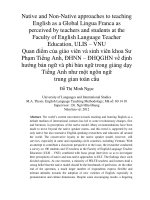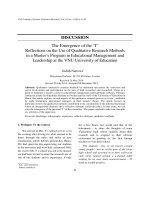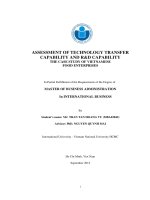Sweetpotato Processing and Product Research and Development at the Sichuan Academy of Agricultural Sciences
Bạn đang xem bản rút gọn của tài liệu. Xem và tải ngay bản đầy đủ của tài liệu tại đây (51.12 KB, 13 trang )
Chapter 9
Sweetpotato Processing and Product Research and Development
at the Sichuan Academy of Agricultural Sciences
Xie Jiang1 , Hu Jianjun2 and Wang Yi3
Abstract
This article presents the technology developed by the Sichuan Academy of
Agricultural Sciences (SAAS) in processing sweetpotato into food products including
starch, snack foods, whole nutrition flour and their by-products. The technology can
also be used to process potato, canna (Canna edulis), cassava and other agricultural
products.
Keywords : potato, sweetpotato, food processing, starch, snack food, whole nutrition
flour
Introduction
Sweetpotato is an important source of human food and animal feed. In Sichuan
Province, China, it is popularly referred to as “the green golden mine” that should be
fully developed. The annual sweetpotato production area in the Sichuan Basin
(including Sichuan province and Chongqing municipality) is more than 1.33 million
hectares. The total production is 23 million tons and ranks first in China. This
production contributes 18.5% of total sweetpotato production in the world. This is
greater than the total production of all countries in the world, except China. Thus,
research and development of sweetpotato in Sichuan is very important.
Sweetpotato is mainly planted in hilly lands and mountainous regions in the
Sichuan Basin. Typically, it is intercropped with corn and wheat, although it is
1
Food and Root Crops Processing Research Scientist, Crop Research Institute, Sichuan Academy of Agricultural
sciences, Cheng Du, P.R .China, 610066.
2
Food and Root Crops Processing Research Scientist, Crop Research Institute, Sichuan Academy of Agricultural
sciences, Cheng Du, P.R .China, 610066.
3
CIP-China liaison scientist, International Potato Center (CIP) Liaison Office, Chinese Academy of Agricultural
Sciences, Beijing, 100081
114
occasionally planted alone after the harvest of wheat. The cropping system is
wheat/corn/sweetpotato.
Sweetpotato is usually planted in nurseries in March, and transplanted from
nurseries to the field from late May to early June. Harvest takes place from late October
to early November, after a growing period of 150 to 160 days. The high yield of
sweetpotato is due to favorable temperature, sunlight, and rainfall. Based on the
experiment of the Sichuan Academy of Agricultural Scinces (SAAS), the use of
newly-bred varieties can produce 70 to 75 tons per hectare when planted as a monocrop
and 45 to 50 tons per hectare when intercropped.
Sweetpotato is a high yielding crop with wide adaptation and high resistance to
drought. However, the actual yields range only from 16 to 17 tons per hectare, which is
only 40% of the yield of new varieties. Thus, there is significant potential to increase
production in Sichuan. During the past 20 years, the yield of rice, wheat and corn per
hectare increased by 64%, 67%, and 43% respectively while the total production
increased by 57%, 82% and 51% respectively. In comparison, the yield of sweetpotato
only increased by 3.8% while total production declined by 5.7% during the same period.
Why did the yield of sweetpotato almost stagnate? The research showed that this
pattern was due to the backwardness of sweetpotato processing and utilization. At
present, about 70% of the total sweet potato production is used as feed for pigs. Only
10% of total sweetpotato production is consumed as human food. Moreover, 10-15% of
the total production is lost due to rotting because of high water concentration. Thus,
there is a need for a continued effort to develop sweetpotato production towards: 1)
enhanced processing and breeding research, 2) improved sweetpotato processing
technology and equipment, 3) improved quantity and quality of sweetpotato varieties
and their processing products, and 4) increased income of farmers.
Before the mid 1980’s, the proportion of sweetpotato being processed was less
than five percent of the total production while the major products are coarse starch and
low quality general noodles. During the past fifteen years, SAAS and the International
Potato Research Center (CIP) have jointly conducted the breeding of new sweetpotato
cultivars and the development of sweetpotato processing technology and equipment.
The results have been demonstrated and extended in Santai, Anyue, Nanchong,
Mianyang, Yilong counties in Sichuan Province and other potato and sweetpotato
planting areas throughout the country. The impact of the project was remarkable. For
instance, the proportion of sweetpotato for processing increased to 10% in Sichuan
recently. The breakthrough on the technology of sweetpotato whole nutrition flour,
starch, noodles, potato and sweetpotato instant noodles and other snack foods have
been made and they are good models for large scale sweetpotato processing in Sichuan,
as well as in China in general.
115
Research and utilization of sweetpotato processing technology
The noodles and starch technology
Generally, the climate is cloudy, humid, and windy when sweetpotato is
harvested. These climatic conditions create problems in the processing of sweetpotato
into slices, starch and noodles. In response to this, in the early 1990s SAAS and CIP
developed a small-scale processing technology. The technology includes small
processing equipment and a corresponding technological process suitable for use by
farmers. The technology increases the efficiency, reduces hard work, and improves the
quality of processed sweetpotato into starch and noodles. In 1993, the National
Committee of Science and Technology listed the technology as one of the “National
Key Extension Program of Scientific Achievements”. It also won the Second Prize for
Scientific Achievement in Sichuan Province in 1994. The set of machines of its
technologies has been extended to more than 100 counties in over 20 provinces in
China and abroad. Recently, the technology has been further developed and combined
with refined starch and instant noodle production with medium and large scale
enterprises, and has proven to be popular in Sichuan.
Sweetpotato starch processing technology
Figure 1 illustrates the traditional processing of early sweetpotato starch by
hand. The starch processing method newly developed by the project is shown in Figure
2.
The project has improved the processing of sweetpotato into starch by means of
the “sour liquid” method, choosing the right type of smashing machine (saw drum or
hammer machine), chosing with the best sieve design (a curved sieve plate with
specific mesh size), and improving the refining technology. With these improvements,
the starch extraction rate increased from 13 to 15 percent, work efficiency rose from 2.3
to 4 times, power consumption dropped by 50 percent, and starch quality was greatly
improved. As a result, profits from using the new technology was 1.9 to 3.9 times more
than what they were with the traditional method of processing sweetpotato into starch.
The starch derived from the improved process is widely used in for making instant
noodles and other products.
Sweetpotato noodles processing technology
Figure 3 shows the traditional method of processing sweetpotato noodles. The
traditional process takes a long time and efficiency is low due to the complex procedure.
The study found that the basic principles in processing sweetpotato noodles like mixing,
116
making gelatinous soup, and precipitation of starch heavily depend on factors like
moisture content, temperature, pH value of the mixed starch paste, and the amount of
salt.
After analyzing the relationship between these factors and the quality of noodles,
the best mechanized procedure for good quality noodles processing is detailed in Figure
4. Figure 4 shows that the use of machines has taken off the arduous task of pounding
by hand. As a result, work efficiency has increased. The distinct taste of noodles made
by manual processing was maintained even though the processing was mechanized.
Furthermore, work efficiency doubled resulting to a profit increase of 1.5 to 1.7 times
more than the traditional method. SAAS has designed, enhanced and manufactured
different sets of relevant starch and noodle equipments such as mixer, vacuum mixer,
noodle-boiler, noodle-separator, and freezer for mass fabrication in medium and small
scale. It has also collaborated with machine manufacturers. The Rei Fa Food Company
in Anyue County, Sichuan province has successfully adopted the technology system
including the machinery. The extension and utilization of the machines have shortened
the process of making sweetpotato noodles. Thus, more medium-sized noodle
enterprises which have realized the advantages of the new system are eager to adopt the
technology and machine.
Research and popularization of instant potato and sweetpotato noodles (IPSN)
Characteristics of the product
The new technology to produce nutritional starch instant noodles from
sweetpotato was a product of years of starch and noodle research by the SAAS in
cooperation with CIP. The project has developed two methods in making instant
noodles: extruding method and sheeting method. The product from sheeting method is
also called the nutritional starch instant noodle (IPSN) because of specific ingredients
and processing procedure. The IPSN has many advantages when compared with
products produced by the manual extruding method. These include:
a.
Storage convenience and ease in preparation.
Like instant wheat noodle, IPSN is ready to eat after soaking in hot water
(>80°C for 5 minutes, unlike the ordinary noodles that need to be cooked in boiling
water for ten minutes. This makes IPSN suitable for regular family meals and
snacks.
b.
More nutritious
IPSN contains more dietary fiber, amino acids, mineral elements, and
vitamins than the normal starch noodles. The higher nutritional value of IPSN
117
comes from a mixture of potato and sweetpotato flour and other ingredients
compared to normal noodles which come a mixture of 100% potato or sweetpotato
starch only.
c.
Better mouth feel and shape
This is made possible by the advanced sheeting technique and the use of
machines that have better design. The noodles do not easily break after being
soaked for a long time and has a more chewy texture than the normal noodle.
Characteristics of the technology
a. Special process and advanced technique
In dextrin (heating) process, a special technique and machine are used to
continuously carry out the whole production process while the quantity and quality
of noodles are guaranteed. The cooperative enterprise of SAAS was the first to
successfully use the technology, which has already been awarded a patent by the
state.
b. Cheaper and easily combined with existing processing equipment
Lower investment is needed to procure the machine. At the same time, it
can be easily combined with the existing primary starch processing machinery in
the manufacturing plants. As a result, higher profits accrue to the farmers and the
basic processors.
c.
Wider application
This technology is not only suitable for sweetpotato starch and flour mixes,
but also for mixing in starch from potato, corn, pea, canna (Canna edulis), cassava
and others, depending on the desired taste and texture of the final product.
Sweetpotato snack foods
Sweetpotato snack foods are popular in Sichuan because of it is fairly sweet,
has delicious flavor and a bright color. During the past ten years, SAAS has succeeded
in developing other kinds of new potato and sweetpotato snack foods such as chips
(made from sweetpotato roots or made from flour by steaming, slicing, drying, frying,
seasoning, mixing, and packing), crispy sweetpotato cakes (a mixture of sweetpotato,
egg and wax rice flour), low sugar sweetpotato candy, and vacuum- fried potato and
sweetpotato sticks/chips. The technology developed by the SAAS for vacuum fried
potato and sweetpotato sticks/chips is explained below.
Vacuum frying method is a new technology developed by SAAS. By frying at a
118
low temperature (80-90°C), the original flavor, color and nutritional composition of
raw sweetpotato are well preserved. The medium and small- scale vacuum frying
machines designed by SAAS are inexpensive and good quality. Thus, small to
medium enterprises can easily acquire it. This technology can be used to produce many
kinds of fried snack foods such as potato, sweetpotato, apple, carrot, pea, broad beans,
banana, and meat. The procedure for vacuum frying method is shown in Figure 5.
Sweetpotato whole nutrition flour
Characteristics of the sweetpotato whole nutrition flour
The sweetpotato whole nutrition flour can be directly used as food or as raw
materials for processing into other food products. The flour keeps all the nutrition
elements of fresh sweetpotato that the starch does not have. It is called “sweetpotato
whole nutrition flour” or “sweetpotato whole flour”. The research improvement by
SAAS to develop this product included the following:
a. The whole nutrition sweetpotato flour maintains the color, flavor, and most of
the nutritional composition and curative elements of fresh sweetpotato roots
such as vitamins, dietary fiber, polysaccharide-protein, physiological alkaline
ingredients, soluble sugar, calcium, and phosphorus. The product is a healthy
food with curative effect, thus greatly encouraged by the government and
well-known scientists. A compositional analysis of the product by SAAS
yielded the information shown in Table 1.
b. The product is convenient to eat and has good taste and flavor. When the flour is
mixed with water, it recovers the flavor of fresh cooked sweetpotato and tastes
very well.
c. The product can be stored for a long time, and is available all year round. By
contrast, fresh sweetpotato roots can only be used within 4-5 months.
d. The product can be used as raw material for making processed food products by
households and by restaurants. There are many potential food products that can
be made from whole nutrition sweetpotato flour: fried sweetpotato cakes,
compound sweetpotato nutrition flour for instant food, extruded sweetpotato
chips, sweetpotato breads, sweetpotato noodles or instant noodles, sweetpotato
ice creams, and sweetpotato porridge.
The processing procedure of the sweetpotato whole nutrition flour is shown in
Figure 6.
119
The technology of sweetpotato whole nutrition flour
The whole sweetpotato nutrition flour technology has solved the problems of
high cost of drying from high level water content of roots of 68-72 percent, darkening,
and deterioration of taste during processing. The technology includes the application of
economic (minimum) energy cost, microwave technology, super-fine flour making
technology and swelling technology. These technologies are already patented in China.
The equipment and technology made processing of sweetpotato products from
the flour possible all year round. It can also process other dried and powdered products
such as pumpkin, corn, potato and carrot.
The small machine can produce high quality products with lower investment. At
the same time, the technology is also suitable for large, medium and small-scale
enterprises and is also compatible with the primary processing of processing systems of
large enterprises. Thus, farmers can finish more primary processing, resulting in higher
incomes.
Demonstration and extension of processing technology
The demonstration and extension of sweetpotato processing technology to
farmers and enterprises in Sichuan have been facilitated by the cooperation between
CIP and SAAS since 1990. The local governments have also strongly supported the
project. Therefore, the sweetpotato production and processing have greatly improved in
Anyue, Shantai, Mianyang, Nanchong, and Guanghan counties of Sichuan. The
increased income of farmers from improved technology has contributed to the
promotion of local agricultural economy.
Sweetpotato whole nutrition flour
Yilong County is one of the largest sweetpotato producing counties in Sichuan
province. The average sweetpotato production is about 0.4 to 0.5 million tons per year.
A cooperator of SAAS, the Yilong Green Food Limited Corporation founded in 1997
was the first demonstration factory for sweetpotato whole nutrition flour in China. The
total investment was 2.50 million Yuan (US$0.30 million). It produces a total of 500
tons of whole nutrition flour and 1000 tons of compound sweetpotato powder annually.
Its annual contribution to local farmers is estimated 3.40 million Yuan (US$0.41
million). This product has been successfully used to make instant sweetpotato flour,
sweetpotato steamed bread flour, sweetpotato fried cake flour and some other food
products. The technology will be further extended in Sichuan Province and in the whole
120
China.
The largest sweetpotato noodle processing county in Sichuan
Since the mid-1980s, scientists from SAAS and CIP researched and developed
technology for sweetpotato starch and noodle processing in Santai county. The farmers
were trained in the demonstrating factories, and some were able to learn quickly.
Yong-Chun Sweet Potato Company, which produces starch and noodle machines, and
Guang You Special Roots Company, which produces noodles and manufactures
processing machines, are some of the companies that use the technology from SAAS.
They have been both well-supported by SAAS and CIP project scientists. These
companies have progressed very well and have also greatly influenced many other
potato and sweetpotato processing enterprises. In 2001, total noodle production in
Santai county was 120,000 tons with a total sales value of 480 million Yuan (US$58
million). The locally made machines for sweetpotato starch and noodles were sold in
more than 20 provinces in China. The average income of a processing farm family was
estimated to be three times more than the non-processing farmers. The annual income
of a processing family was 4530 Yuan (US $ 548), 85% of these income derived from
sweetpotato processing.
The town of sweetpotato noodles – Zhouli Town of Anyue County
Anyue County ranks first in Sichuan province in terms of sweetpotato
production. The average annual sweetpotato planting area in the county is over 30,000
hectares and total production is about 0.75 million tons. Under the guidance and help of
SAAS and CIP, sweetpotato starch and noodle production has gradually shifted from
traditional to modern scientific techniques, and towards 1arger scales of production.
Specifically, scientists from SAAS and CIP have improved the sweetpotato processing
technology and trained farmers and some enterprises in Zhouli Town of Anyue County.
The major changes brought about by the new technology are quality improvement of
starch and noodles and the doubling of income from production and sales. In 2000, the
total noodle production of the town was 60,000 tons amounting to 190 million Yuan
(about US $ 24 million). This value is ten times more than the earnings ten years ago.
Currently, 90 percent of the farmers are involved in noodle processing. A team of
professional transportation groups and traders for wholesale has been organized while
four sweetpotato starch and noodle specialized markets have been set up. The business
is progressing very well. The noodles are sold to more than 20 provinces daily. Zhouli
Noodle Industry Society, a special farmers’ association which was organized in Zhouli
Town in 1997, helps to promote the local industry and its products.
121
Potato and sweetpotato instant noodles
In recent years, instant noodles has become more and more popular in Sichuan.
This product originated from the sweetpotato noodle and refined starch that SAAS
researched before. Currently, there are at least three large-scale enterprises producing
instant potato and sweetpotato instant noodle with the annual output of more than 5000
tons. Meanwhile, under the guidance and technical support of SAAS, the new instant
noodle technology known as the “Sheeting Method” has been successfully used. Instant
noodle has become a very popular food in Sichuan and many provinces of China.
Further research and popularization of this product by SAAS are currently ongoing.
Sweetpotato snack foods of vacuum frying sticks and chips
In the course of disseminating the vacuum frying new technology and machines
for potato and sweetpotato sticks and slices, the SAAS set up sample factories in the
provinces of Sichuan province and some other provinces such as Guizhou, Chongqing,
Guangdong, Guangxi and Tibet autonomous region. The products are very popular,
especially among young people.
Prospects of sweetpotato processing in Sichuan
Sweetpotato processing has reached an industrial scale and has contributed to
the growth of the local economy during the past ten years. It has enabled many farmers
to get out of poverty. Yet, the sweetpotato processing industry is still not big enough
and only utilizes about 10% of the total sweetpotato output. There are still problems in
sweetpotato processing that need to be studied, particularly on technology and product
quality. There is also a need to develop new high value-added products. Research
priorities include study of the physical and chemical characteristics of starch and
distinct traditional food from sweetpotato. Research and development of sweetpotato
processing should focus on the following concerns:
1) The physical and chemical characteristics of potato and sweetpotato starch and
trial products’ application for the modified starches
2) Distinct traditional foods
3) Instant foods and snack foods
4) Further usage and research of the whole nutritional sweetpotato flour
Acknowledgements
The autho rs would like to thank Michael Hermann for his valuable comments and
suggestions on this paper.
122
Table 1. Results of the analysis of the whole nutrition sweetpotato flour, 1995
Products
Sweetpotato
Roots
Sweetpotato flour
1
(pure flour)
2
Complex
sweetpotato flour
(instant flour)3
Items
Soluble sugar (%)
4.95
39.50
72.50
7.06
2.75
Protein (%)
1.50
5.56
13.40
Lipids (%)
0.17
0.85
8.87
Moisture (%)
Carbohydrate (%)
60.98
Coarse fiber (%)
0.62
1.58
2.90
Ash (%)
0.62
1.94
3.62
268.02
0.13
294.51
Phosphorus (%)
0.043
0.164
118.69
Iron (mg/kg)
17.98
74.5
11.66
ß-carotene (mg/kg)
14.74
27.58
0.093
Vitamin B1 (mg/100g)
0.132
0.498
0.853
Vitamin B2 (mg/100g)
0.027
0.164
0.32
Vitamin C (mg/100g)
27.00
1.20
29.91
Vitamin B5
15.00
20.00
Calcium (%)
(ug/g)
Amino-acid (%)
9.07
Note: 1) comes from the new variety of fresh root bred by SAAS.
2) comes from the root of the same sweetpotato variety as 1).
3) comes from the flour of 2), and some other food auxiliary materials are added.
123
Figure 1. Traditional processing of sweet potato starch
Select sweet
potato
Change water
(second day)
Wash sweet
potato by hand
Mash sweet
potato by hand
Free mixture w/ contaminants
(precipitation)
Remove top layer with residue and
bottom layer with sandy mud
Filter by hand 1 to 2 times
to form thick starch liquid
Get wet starch
(third day)
Hang up to sun
dry from 5-10 days
Dried starch
Figure 2. Starch processing using the developed technology
Wash
sweetpotato
Wash
sweet
potato
By
bymachine
hand (?)
Select sweet
potato
Deposit in pool
to form wet
starch
Filter by machine to form
thick liquid (with sour
liquid)
Refining
Refining
By machine
Hang up to dry
(sun drying or
artificial)
potato
Smash sweet
sweetpotato
By machine
by hand (?)
Dried
starch
OR
Hang up wet
starch
Direct use or
dry
124
Figure 3. The traditional method of processing sweet potato noodles
Starch
Add boiling
water
Make gelatinous
soup
Hang the
noodles
Arrange
noodles
Treat noodles
in the sulfur
room
Dry in
the sun
Mix with the rest of
the starch
Cool down in
water pool
Sift through
the holes
Make gelatinous soup in
boiling water
Pack the
noodles
Figure 4. Mechanized processing of sweetpotato noodles
Starch, water
and ameliorator
Mixing
Pack
noodle
Make noodles
using machine
Separate
noodles
125
Cut
noodles
Cool down
noodles
Figure 5. The vacuum frying technology
Raw materials (fresh potato
& sweetpotato roots)
Final
product
Washing
Packing
Cutting
Mixing
Seasoning
treatment e.g.
bleaching
Vacuum
frying
Figure 6. The sweetpotato whole nutrition flour processing technology
Fresh sweet potato
roots)
Smashing
into powderlike product
Sieving
Washing
Peeling
Microwave
treatment
Drying
Packing
126
Cutting
Cooking
(gelatinous
mixture
with
steamer









